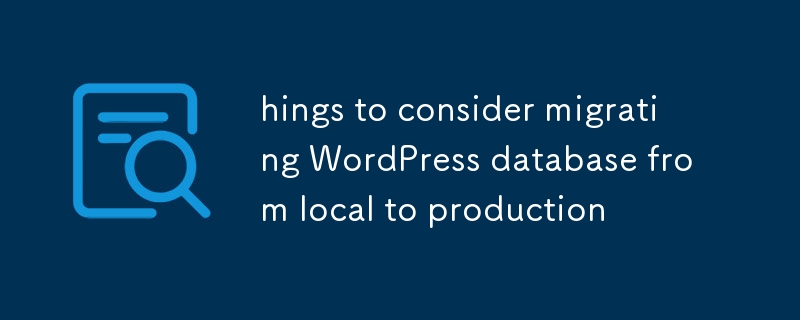
Migrating a database from local environment to production server can feel overwhelming, but with the right approach, it doesn’t have to be. In this guide, I'll walk through the key points you need to consider ensuring a smooth migration process.
Key Considerations for Database Migration
1. Scheme (Protocol)
Example: http or https
2. Domain Name
Local examples: localhost, localhost/wordpress, wordpress.test
Production example: acme.com
3. URLs in the WordPress Database
1. Scheme (Protocol)
This is fairly simple. When developing locally, we often start with http, but as the project progresses or when we prepare for production, we might switch to https. The key is to make sure that all URLs in the database's table use the same scheme as your production site. If your production site uses https, you’ll need to update the local URLs before migration.
2. Domain Name
In local development, your site might use a URL like localhost/wordpress, but in production, it will use your live domain, such as acme.com. During migration, all instances of the local domain need to be replaced with the live production domain in your database's table.
3. Types of URLs in WordPress
WordPress stores URLs in different formats across the database's table.
-
Literal URL:
- Example: http://localhost/wordpress
-
Escaped URL: Used in serialized data where characters need to be escaped.
- Example: http:\/\/localhost\/wordpress
-
Encoded URL:
- Example: http%3A%2F%2Flocalhost%2Fwordpress
Quick tips:
- %3A stands for :
- %2F stands for /
To manually check or convert encoded URLs, you can use online tools like URL Decoder/Encoder.
Migration Process
To successfully migrate, you’ll need to search for all occurrences of your local URLs (in all three formats) and replace them with your production URLs. Most database tools or plugins, like WP Migrate DB or Search-Replace-DB, can help automate this process.
By paying attention to the scheme, domain name, and the different URL formats in your WordPress database, you can ensure a smooth and successful migration. Happy migrating!
以上是hings to consider migrating WordPress database from local to production的详细内容。更多信息请关注PHP中文网其他相关文章!
 MySQL与Sqlite有何不同?Apr 24, 2025 am 12:12 AM
MySQL与Sqlite有何不同?Apr 24, 2025 am 12:12 AMMySQL和SQLite的主要区别在于设计理念和使用场景:1.MySQL适用于大型应用和企业级解决方案,支持高性能和高并发;2.SQLite适合移动应用和桌面软件,轻量级且易于嵌入。
 MySQL中的索引是什么?它们如何提高性能?Apr 24, 2025 am 12:09 AM
MySQL中的索引是什么?它们如何提高性能?Apr 24, 2025 am 12:09 AMMySQL中的索引是数据库表中一列或多列的有序结构,用于加速数据检索。1)索引通过减少扫描数据量提升查询速度。2)B-Tree索引利用平衡树结构,适合范围查询和排序。3)创建索引使用CREATEINDEX语句,如CREATEINDEXidx_customer_idONorders(customer_id)。4)复合索引可优化多列查询,如CREATEINDEXidx_customer_orderONorders(customer_id,order_date)。5)使用EXPLAIN分析查询计划,避
 说明如何使用MySQL中的交易来确保数据一致性。Apr 24, 2025 am 12:09 AM
说明如何使用MySQL中的交易来确保数据一致性。Apr 24, 2025 am 12:09 AM在MySQL中使用事务可以确保数据一致性。1)通过STARTTRANSACTION开始事务,执行SQL操作后用COMMIT提交或ROLLBACK回滚。2)使用SAVEPOINT可以设置保存点,允许部分回滚。3)性能优化建议包括缩短事务时间、避免大规模查询和合理使用隔离级别。
 在哪些情况下,您可以选择PostgreSQL而不是MySQL?Apr 24, 2025 am 12:07 AM
在哪些情况下,您可以选择PostgreSQL而不是MySQL?Apr 24, 2025 am 12:07 AM选择PostgreSQL而非MySQL的场景包括:1)需要复杂查询和高级SQL功能,2)要求严格的数据完整性和ACID遵从性,3)需要高级空间功能,4)处理大数据集时需要高性能。PostgreSQL在这些方面表现出色,适合需要复杂数据处理和高数据完整性的项目。
 如何保护MySQL数据库?Apr 24, 2025 am 12:04 AM
如何保护MySQL数据库?Apr 24, 2025 am 12:04 AMMySQL数据库的安全可以通过以下措施实现:1.用户权限管理:通过CREATEUSER和GRANT命令严格控制访问权限。2.加密传输:配置SSL/TLS确保数据传输安全。3.数据库备份和恢复:使用mysqldump或mysqlpump定期备份数据。4.高级安全策略:使用防火墙限制访问,并启用审计日志记录操作。5.性能优化与最佳实践:通过索引和查询优化以及定期维护兼顾安全和性能。
 您可以使用哪些工具来监视MySQL性能?Apr 23, 2025 am 12:21 AM
您可以使用哪些工具来监视MySQL性能?Apr 23, 2025 am 12:21 AM如何有效监控MySQL性能?使用mysqladmin、SHOWGLOBALSTATUS、PerconaMonitoringandManagement(PMM)和MySQLEnterpriseMonitor等工具。1.使用mysqladmin查看连接数。2.用SHOWGLOBALSTATUS查看查询数。3.PMM提供详细性能数据和图形化界面。4.MySQLEnterpriseMonitor提供丰富的监控功能和报警机制。
 MySQL与SQL Server有何不同?Apr 23, 2025 am 12:20 AM
MySQL与SQL Server有何不同?Apr 23, 2025 am 12:20 AMMySQL和SQLServer的区别在于:1)MySQL是开源的,适用于Web和嵌入式系统,2)SQLServer是微软的商业产品,适用于企业级应用。两者在存储引擎、性能优化和应用场景上有显着差异,选择时需考虑项目规模和未来扩展性。
 在哪些情况下,您可以选择SQL Server而不是MySQL?Apr 23, 2025 am 12:20 AM
在哪些情况下,您可以选择SQL Server而不是MySQL?Apr 23, 2025 am 12:20 AM在需要高可用性、高级安全性和良好集成性的企业级应用场景下,应选择SQLServer而不是MySQL。1)SQLServer提供企业级功能,如高可用性和高级安全性。2)它与微软生态系统如VisualStudio和PowerBI紧密集成。3)SQLServer在性能优化方面表现出色,支持内存优化表和列存储索引。


热AI工具

Undresser.AI Undress
人工智能驱动的应用程序,用于创建逼真的裸体照片

AI Clothes Remover
用于从照片中去除衣服的在线人工智能工具。

Undress AI Tool
免费脱衣服图片

Clothoff.io
AI脱衣机

Video Face Swap
使用我们完全免费的人工智能换脸工具轻松在任何视频中换脸!

热门文章

热工具

VSCode Windows 64位 下载
微软推出的免费、功能强大的一款IDE编辑器

ZendStudio 13.5.1 Mac
功能强大的PHP集成开发环境

螳螂BT
Mantis是一个易于部署的基于Web的缺陷跟踪工具,用于帮助产品缺陷跟踪。它需要PHP、MySQL和一个Web服务器。请查看我们的演示和托管服务。

记事本++7.3.1
好用且免费的代码编辑器

mPDF
mPDF是一个PHP库,可以从UTF-8编码的HTML生成PDF文件。原作者Ian Back编写mPDF以从他的网站上“即时”输出PDF文件,并处理不同的语言。与原始脚本如HTML2FPDF相比,它的速度较慢,并且在使用Unicode字体时生成的文件较大,但支持CSS样式等,并进行了大量增强。支持几乎所有语言,包括RTL(阿拉伯语和希伯来语)和CJK(中日韩)。支持嵌套的块级元素(如P、DIV),





